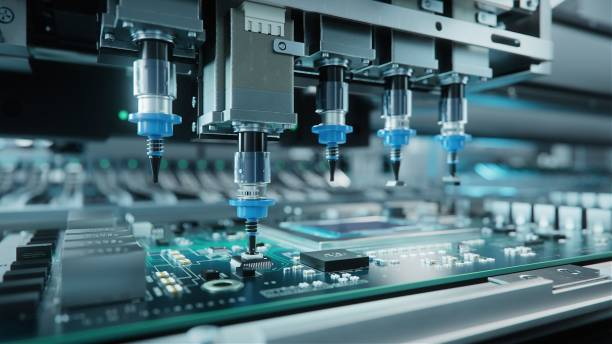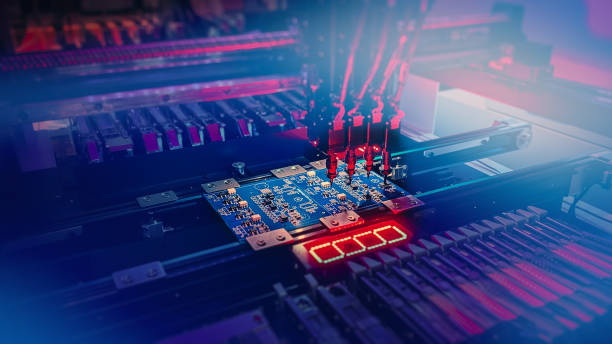Content Menu
● Understanding SMT Stencils
>> The Importance of SMT Stencils in PCB Assembly
● Types of SMT Stencils
>> 1. Framed SMT Stencils
>> 2. Frameless SMT Stencils
>> 3. Step Stencils
>> 4. Nanocoated Stencils
● Factors to Consider When Choosing an SMT Stencil
>> Stencil Thickness
>> Stencil Material
>> Aperture Design
>> Manufacturing Process
● Optimizing Stencil Design for Different Component Types
>> QFPs and QFNs
>> BGAs and CSPs
>> 0201 and 01005 Components
● Advanced Stencil Technologies
>> Nanocoating
>> Multi-Level Stencils
● Stencil Design Considerations for Special Applications
>> Through-Hole Component Printing
>> Flexible PCB Stencils
>> High-Density Interconnect (HDI) PCBs
● Stencil Maintenance and Care
● Conclusion
● FAQ
>> 1. What is the typical lifespan of an SMT stencil?
>> 2. How do I clean an SMT stencil properly?
>> 3. Can I reuse a frameless SMT stencil?
>> 4. How do I determine the right aperture size for my components?
>> 5. What are the advantages of using a step stencil?
● Citations:
Selecting the appropriate SMT (Surface Mount Technology) stencil is crucial for ensuring high-quality PCB (Printed Circuit Board) assembly. The right stencil can significantly impact the accuracy and consistency of solder paste application, which in turn affects the overall performance and reliability of your electronic devices. This comprehensive guide will walk you through the essential factors to consider when choosing an SMT stencil for your PCB project.

Understanding SMT Stencils
SMT stencils, also known as PCB stencils or solder paste stencils, are thin metal sheets with precisely cut apertures that correspond to the solder pad locations on a PCB[1]. These stencils play a vital role in the SMT assembly process by allowing for the accurate deposition of solder paste onto the PCB surface.
The Importance of SMT Stencils in PCB Assembly
SMT stencils are key components in achieving high-quality SMT assembly results[9]. They enable:
1. Precise solder paste application
2. Consistent solder joint formation
3. Reduced risk of defects and errors
4. Improved overall product functionality and performance
Types of SMT Stencils
Before delving into the selection process, it's essential to understand the different types of SMT stencils available:
1. Framed SMT Stencils
Framed stencils are permanently mounted in a metal frame, offering superior stability and reusability[1]. They are ideal for high-volume production runs due to their:
- Better positional accuracy
- Improved dimensional stability
- Ease of handling and alignment
However, framed stencils are more expensive and require more storage space compared to frameless options[1].
2. Frameless SMT Stencils
Also known as foil stencils, frameless stencils are more cost-effective and space-efficient[3]. They are suitable for:
- Low-volume production
- Prototyping
- Situations where storage space is limited
While they offer flexibility, frameless stencils may require additional effort for proper tensioning during use.
3. Step Stencils
Step stencils feature varying thicknesses across different areas of the stencil[7]. This design allows for:
- Optimized solder paste volume for different component types
- Improved printing performance for mixed-technology boards
4. Nanocoated Stencils
Nanocoated stencils feature a special surface treatment that enhances their performance[5]. Benefits include:
- Improved solder paste release
- Reduced risk of solder bridging
- Extended stencil lifespan
Factors to Consider When Choosing an SMT Stencil
Stencil Thickness
The thickness of your SMT stencil is a critical factor that directly influences the amount of solder paste deposited on the PCB[2]. Consider the following guidelines:
- For components with a pitch ≤ 0.5mm, use a thickness of 0.12mm to 0.13mm
- For components with a pitch > 0.5mm, opt for a thickness between 0.15mm and 0.20mm
- For BGAs with a ball pitch > 1.0mm, choose a 0.15mm thickness
- For BGAs with a ball pitch between 0.5mm and 1.0mm, use a 0.13mm thickness
When dealing with a mix of component types, prioritize the thickness requirements of the smallest components or the most critical BGAs[2].
Stencil Material
The choice of stencil material affects durability, precision, and paste release properties. Common options include:
1. Stainless Steel: The most widely used material, offering a good balance of cost and performance[6].
2. Nickel: Particularly suitable for fine-pitch applications due to its smooth aperture walls and high durability[6].
3. Fine Grain Stainless Steel: Offers improved performance over standard stainless steel, with smoother stencil walls and crisper steps[5].
Aperture Design
The design of stencil apertures is crucial for ensuring proper solder paste release and deposit formation. Consider the following aspects:
- Aspect Ratio: The width of the aperture divided by the stencil thickness (W/T) should be at least 1.5[2].
- Area Ratio: The surface area of the aperture divided by the surface area of the aperture walls should be at least 0.66[2].
- Aperture Shape: Tapered or stepped apertures can improve paste release for challenging components[5].
Manufacturing Process
The method used to create the stencil apertures can impact print quality and stencil longevity. Common techniques include:
1. Laser Cutting: Offers high precision and is suitable for most applications[5].
2. Electroforming: Provides extremely smooth aperture walls, ideal for ultra-fine pitch components[6].
3. Chemical Etching: Can be used for less demanding applications or prototype stencils[10].

Optimizing Stencil Design for Different Component Types
QFPs and QFNs
For Quad Flat Packages (QFPs) and Quad Flat No-leads (QFNs):
- Use rectangular apertures with rounded corners to improve paste release
- Consider reducing the aperture size by 10% for fine-pitch components (≤ 0.5mm)[1]
BGAs and CSPs
For Ball Grid Arrays (BGAs) and Chip Scale Packages (CSPs):
- Maintain a 1:1 ratio between pad size and aperture size for most applications
- For fine-pitch BGAs, consider using a stepped stencil design to optimize paste volume[2]
0201 and 01005 Components
For ultra-small chip components:
- Use a thinner stencil (0.10mm - 0.12mm) to prevent excessive solder paste deposition
- Consider oversized apertures (110% - 120% of pad size) to ensure sufficient solder volume[2]
Advanced Stencil Technologies
Nanocoating
Nanocoating technology applies a thin, hydrophobic layer to the stencil surface, offering several benefits:
- Improved solder paste release, especially for fine-pitch components
- Reduced stencil cleaning frequency
- Extended stencil lifespan
Consider nanocoated stencils for challenging PCB designs or high-volume production runs[5].
Multi-Level Stencils
For PCBs with a mix of component types and sizes, multi-level stencils can provide optimized solder paste deposition:
- Step-down areas for fine-pitch components
- Step-up areas for larger components or those requiring more solder volume
While more expensive, multi-level stencils can significantly improve print quality and reduce defects in complex PCB assemblies[5].
Stencil Design Considerations for Special Applications
Through-Hole Component Printing
When incorporating through-hole components in an SMT process:
- Design larger apertures to accommodate the increased solder paste volume required
- Consider using a step-up stencil in areas with through-hole components
Flexible PCB Stencils
For flexible PCBs:
- Use a thinner stencil (0.10mm - 0.12mm) to accommodate potential board warpage
- Consider frameless stencils for easier handling and alignment
High-Density Interconnect (HDI) PCBs
For HDI PCBs with ultra-fine features:
- Opt for electroformed nickel stencils for the smoothest possible aperture walls
- Use the thinnest practical stencil thickness to ensure proper paste release
Stencil Maintenance and Care
To maximize the lifespan and performance of your SMT stencils:
1. Clean stencils thoroughly after each use
2. Store stencils in a clean, dry environment
3. Inspect stencils regularly for damage or wear
4. Use proper tensioning for frameless stencils
5. Consider stencil coatings to improve paste release and ease cleaning
Conclusion
Choosing the right SMT stencil for your PCB project is a critical step in ensuring high-quality assembly results. By considering factors such as stencil thickness, material, aperture design, and manufacturing process, you can optimize your stencil for specific component types and PCB layouts. Advanced technologies like nanocoating and multi-level stencils can further enhance performance for challenging applications.
Remember that the best stencil choice often involves balancing various factors and may require some experimentation to achieve optimal results. By following the guidelines presented in this article and staying informed about the latest developments in SMT stencil technology, you can significantly improve the quality and reliability of your PCB assemblies.

FAQ
1. What is the typical lifespan of an SMT stencil?
The lifespan of an SMT stencil can vary depending on factors such as material, usage frequency, and maintenance. On average, a well-maintained stainless steel stencil can last for 3,000 to 5,000 prints. Nanocoated stencils may last even longer, potentially up to 10,000 prints or more.
2. How do I clean an SMT stencil properly?
To clean an SMT stencil:
1. Remove excess solder paste with a dedicated stencil cleaner or isopropyl alcohol
2. Use a soft brush or lint-free cloth to gently scrub the stencil surface
3. Rinse thoroughly with deionized water
4. Dry the stencil completely with compressed air or a lint-free cloth
5. Inspect the apertures to ensure they are clear of any residue
3. Can I reuse a frameless SMT stencil?
Yes, frameless SMT stencils can be reused. However, proper care and storage are essential to maintain their accuracy and performance. When reusing a frameless stencil, ensure it is properly tensioned in a stencil frame or holder to prevent warping or distortion during the printing process.
4. How do I determine the right aperture size for my components?
To determine the right aperture size:
1. Start with the pad dimensions on your PCB design
2. For most components, use a 1:1 ratio between pad size and aperture size
3. For fine-pitch components (≤ 0.5mm), consider reducing the aperture size by 10%
4. For larger components or those requiring more solder, increase the aperture size by 10-20%
5. Always consider the aspect ratio and area ratio guidelines when finalizing aperture dimensions
5. What are the advantages of using a step stencil?
Step stencils offer several advantages:
1. Optimized solder paste volume for different component types on the same PCB
2. Improved printing performance for mixed-technology boards
3. Reduced risk of solder bridging for fine-pitch components
4. Ability to accommodate components with varying height requirements
5. Potential for reduced defects and improved first-pass yield in complex PCB assemblies
Citations:
[1] https://jlcpcb.com/blog/how-to-choose-a-smt-stencil
[2] https://www.7pcb.com/blog/stencil-thickness-calculations
[3] https://www.lioncircuits.com/faq/pcb-assembly/what-is-a-smt-stencil-and-why-is-it-needed-for-assembly
[4] https://www.pcbelec.com/pcb-assembly/pcb-smt-stencil
[5] https://www.ipc.org/system/files/technical_resource/E38&S12-02%20-%20Chrys%20Shea.pdf
[6] https://rigidflexpcb.org/comprehensive-guide-to-smt-stencils/
[7] https://www.becktronic.com/service/faqs/
[8] https://www.viasion.com/pcb-stencil/
[9] https://jlcpcb.com/blog/why-pcb-stencils-are-key-to-high-quality-smt-assembly
[10] https://www.fs-pcba.com/pcb-stencil/
[11] https://www.pcbonline.com/blog/guide-to-smt-stencils.html




















